
|
||
|
Portland art blog + news + exhibition reviews + galleries + contemporary northwest art
|
||
Hanakago: The Art of Bamboo and Flowers at Portland Japanese garden Spring in Portland is incredibly dramatic and the latest exhibition Hanakago: The Art of Bamboo and Flowers at Portland's Japanese Garden is the perfect instrument to sharpen ones senses and appreciation for the season as life awakens around us. There is something about the dried and shaped bamboo among recently cut flowers that suggests the withered husks of life as vessels of contemplation, grace and virtues in life. Both the bamboo and flowers highlight both control and variation through respect. They are perceptual paths to awe and understanding. When the viewer is among these bamboo and flower objects... the weave, the intention and care catches the light and filters our perception towards the fragility that forms constructed in webs of respectful intention entail. We live in an age where consideration and grace can be on short supply so Hanakago is a refreshing respite.
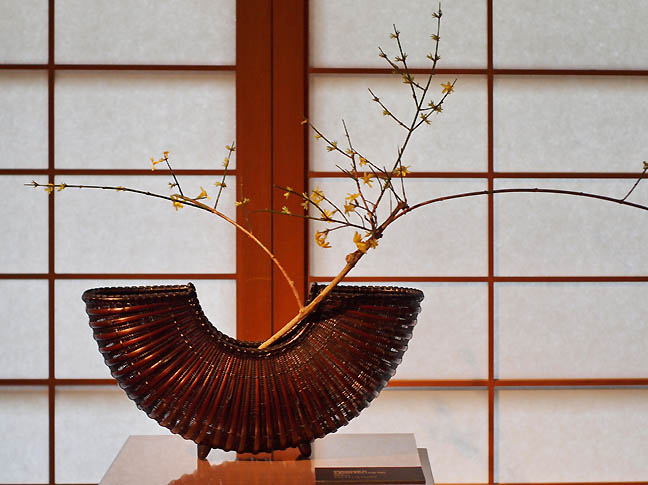
A breeze from long ago, Chinkuunsai III (2012), all photos Jeff Jahn Hanakago is comprised of an impressive array of bamboo baskets and art from Portland collector Peter Shinbach's collection. Many are further brought to life with the ikebana art of Mrs. Etsuho Kakihana and those who study with her. Kakihana is a master teacher of ikebana of the Saga Goryu School at Daikakuji, Kyoto, one of the oldest and most revered Buddhist Temples in Japan. Often, these combinations are enlightening as ikebana is more fleeting while the bamboo objects point to things that have already left life into another state. What is also interesting to this critic is the way 2 art forms can combine and enhance each other. It is rarely seen in most western art practices, with notable exception being the Barnes Collection. Some might call the work in Hanakago "craft" but its more. Craft for most audiences is just a physical/technical consideration (the Greek word for craft is Techne and is the root of the word technique) but as with anything that involves true mastery, it becomes more than that. Made of bamboo, these baskets are inherently precious and the fact that these objects are dead husks brings everything back to very real concerns like death and the passage of time. The end results are often a combination of grace which one can marvel at. 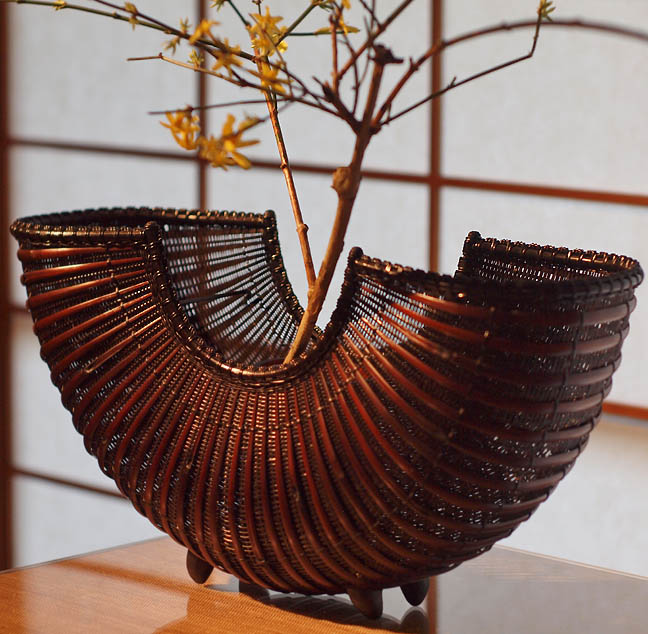 A breeze from long ago (detail), Chinkuunsai III (2012) The first "basket" I wanted to point out is titled, "A breeze from long ago," by Chinkuunsai III. Not a traditional basket form but reminicent of one it is more a sculpture, like an upended elbow macaroni or wheel fender. At the time I saw the work it was inhabited by a ikebana arrangement as well and the way the branch comes out of the center so asymmetrically enlivens both. Here the branch hugs the side and breaks left but eventually the blooms rebalance at the extremities. The basket's creator is also part of the Tanabe family bamboo artisan dynasty from Osaka, where the "Chinkuunsai" title was adopted by the most prominent member of artisans from this family. What I notice first about this particular work is the way the boat-like ribs all focus the eye on the central void, here perfectly filled with ikebana by Saga Goryu School. It is this call and response of the basket as a natural plinth that concentrates the gaze that makes it special (it is now installed differently as the ikebana changes every week). This loading aspect works whether the basket is empty or not. Without an ikebana occupant the basket emphasizes the void, which constitutes the majority of its space. This operates in a way that is similar to the work of Donald Judd. Instead of a pure object, it is essentially a container of volumes with its state of occupancy being emphasized, where anything is present or not. In daily life coming upon the dead outer husk of some dried fruit does the same thing but here there is a man-made intentional construction... implying an awareness and emphasis of the void, like a welcome mat for the eyes. This is much like the way a musician not playing a note has just as much impact as playing one. The shape of that absence being just as crucial to the experience as the shape of physical matter present. 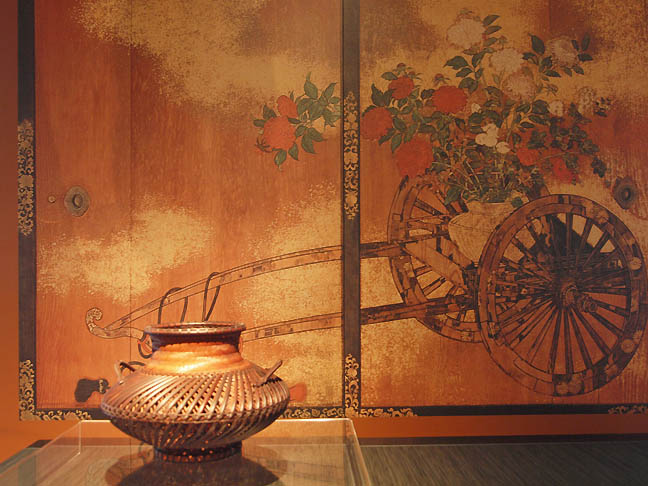 Spiral Pattern Flower Basket, Hayakawa Shokosai V Spiral Pattern Flower Basket, Hayakawa Shokosai V
The next basket that caught my eye was Hayakawa Shokosai V's Spiral Pattern Flower Basket. Designated a Living National Treasure by Japan this work is of the Karamono Style being highly symmetrical and influenced by Chinese aesthetics. Behind it is an illustration showing a similar basket which reminded me that these can be utilitarian objects that become elevated, similar to the Euphronios Krater. Besides the symmetry what I found most interesting is the differing but balanced twill like weavings turning one way then the other, almost like machined gears threading into each other. This makes this symmetrical basket very dynamic, sort of like a very disciplined person sitting down at their desk for a meeting. This very Chinese influenced focus on composure and control highlights the way many of the other works here differ. 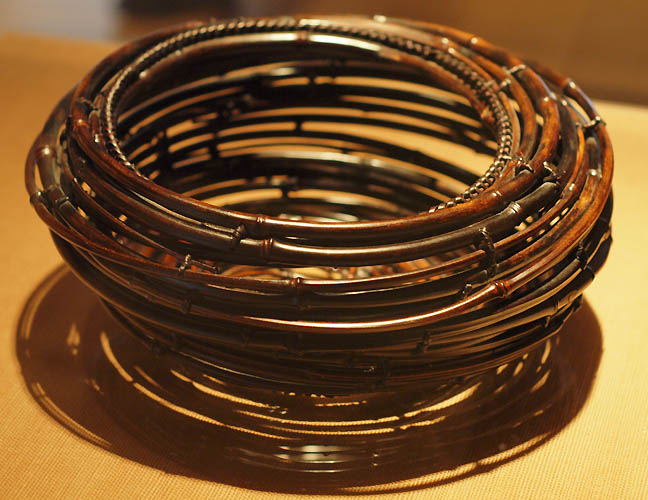 Crane's Nest (1980's), Semeura Shobun Perhaps my favorite basket in the exhibition is the Crane's Nest by Semeura Shobun. Created in the 1980's of Kuruchiku or black bamboo, the basket woven primarily with whole bamboo presents itself in an updated Wamono style. The "wa" of Wamono relates to the idea of Wabi-sabi whose aesthetics celebrate imperfections and natural idiosyncrasies. Thus, the bamboo components are whole and non-standardized, requiring an improvisational mastery of forms from its creator that pays more homage to the material as a natural product as it isnt as processed or milled. The effect is a whirlpool of dark bamboo and somewhat tornadic compared to a real crane's nest (which are more haphazard). What this Crane's Nest showcases is a deft, almost jazzy wobble and rhythmic invention. I am reminded of Sufi dervishes who spin to get closer to their deity and the way spinning forms recall the activity of parents taking care of their young... day in day out routines running similar circles, but all a little different. In Japan cranes symbolize luck through long life and sacrifice but I think an empty nest is even more powerful. 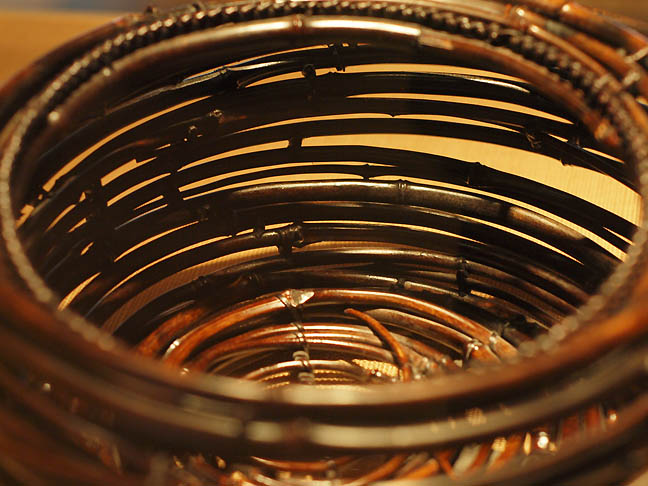 Crane's Nest (detail), Semeura Shobun This basket may have a more natural Wabi-sabi look but it is no less stylized, and it comes off with clean graphic Wabi-sabi lines rather than completely rustic like some other wamono baskets in the show. It also makes sense that this is a more contemporary piece as by the 1980's this sort of stylized version of nature was actually less of a "rustic" peasant or monastic look and more a celebration of nature's nobility. Remember, in the 1980's Japan had become the unlikely #2 economy in the world and the veneration nature presented in a sophisticated way (like sushi, bonsai and ikebana) became a kind of calling card for Japanese culture. The more I think about this piece and the way it is like the way it is architecture as a stylized bird's nest. This is something that many architects have started to emulate and Japanese basketry does scale up to human sized structures well like this Kengo Kuma building. Interesting how baskets are now becoming buildings. I see this basket and I think, dream house. One can also contemplate if this is a new nest waiting to be filled or a an old one where the hatchlings have left and a tribute to the parents? As an art piece these potential ponderings are more important than answers. Lastly, what can be more contemplative of the Spring season than a birds nest? 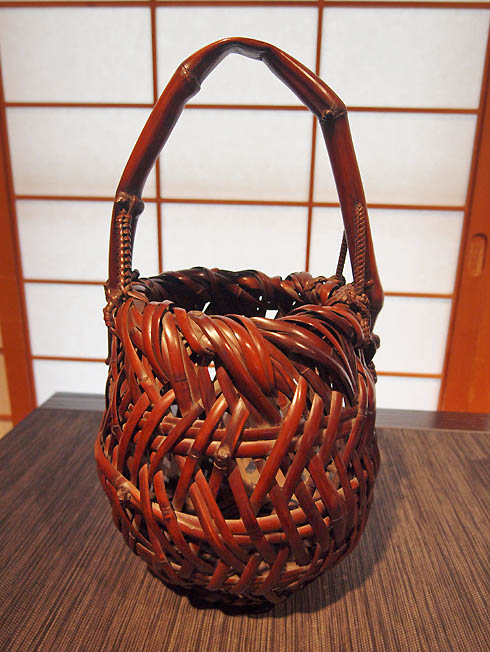 Crouching Tiger, Chinkuunsai I (1920's) Vistors can contrast that basket with a more traditional Wamono style work like Crouching Tiger by Chinkuunsai I. Comprised of several types of bamboo by the first of a dynasty of master weavers from Osaka, all who take the moniker Chinkuunsai. Typical of Wamono style the bamboo comes of as more irregular and rustic, like something you'd expect a wandering monk to carry. Though these objects are hardly the utilitarian anachronistic antiques they appeared to be as they would a part of tea ceremonies and a sign of worldliness, there is a thoughtful nostalgia (as any handmade object has now). The basket is from the 1920's, a time when Japan was rapidly modernizing into a major world power it still looks back. 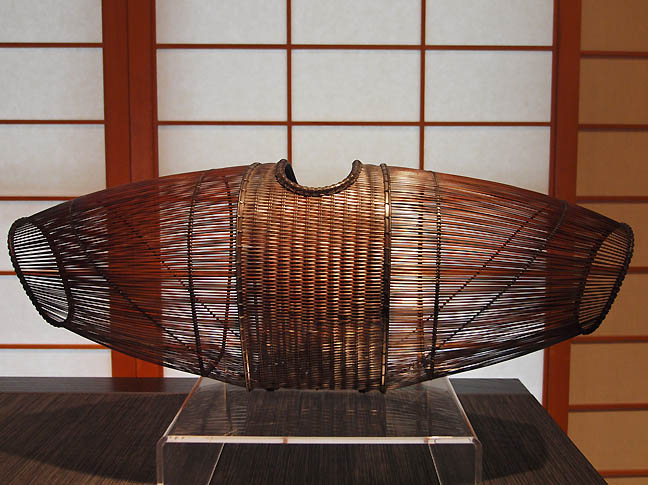 Chivalry (2012), Chinkuunsai IV (title assumed shortly after this work was made) Displayed on the same table as Crouching Tiger is a work by Chinkuunsai IV titled, Chivalry, it also exudes thoughtful nostalgia, depicting a stylized armor like form. It isnt a basket and is more sculpture. It is very interesting to see the sweep of 4 generations in one place. We dont get this generational display much in the USA and a contemporary work from 2012 hearkening back to feudal armor shows how serious the Osaka bamboo masters take this. It gives the exhibition wonderful scope and contrast. Sitting next to one another you can see the pride and technique. 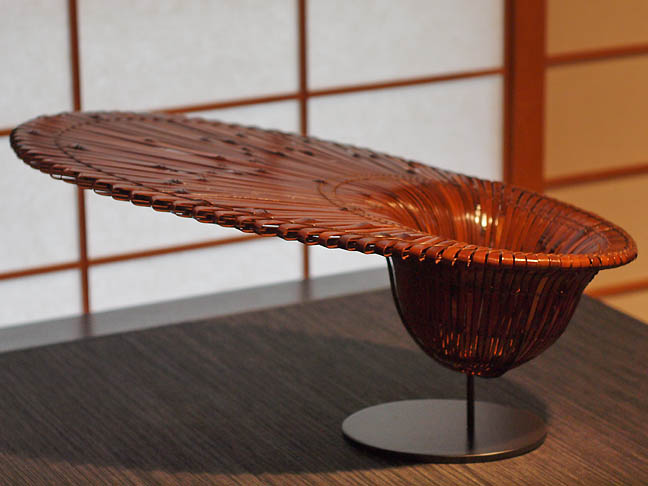
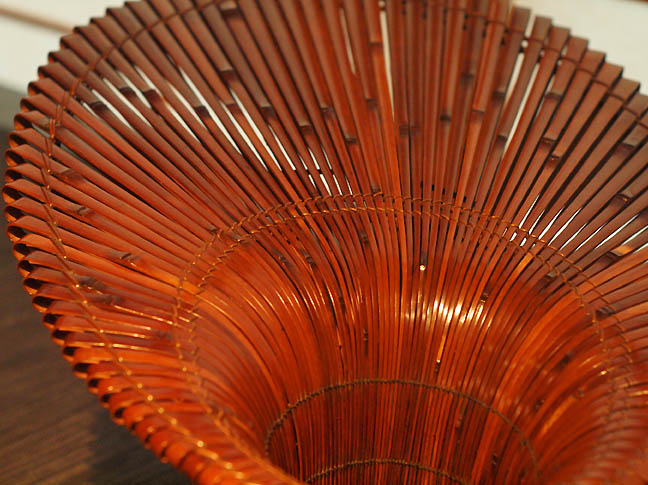 Meteor (2017), Tanioka Shigeo One of my favorite works on display here is Meteor by Tanioka Shigeo. Created in 2017 it is also one of the most recent. Constructed of highly prized Susudake bamboo, which is salvaged sooty material from old farm houses, it stands as a witness to daily activities giving it a rich patina. What the weaver has done here is repurpose it into a stylized cosmological model... like an elongated orbit around warped spacetime the form makes the invisible visible. The knobby knuckles of the bamboo each could be an asteroid or a dwarf planet in the Oort cloud? It is wonderful how salvaged farmhouse material illustrates Einstein's theory of general relativity here. 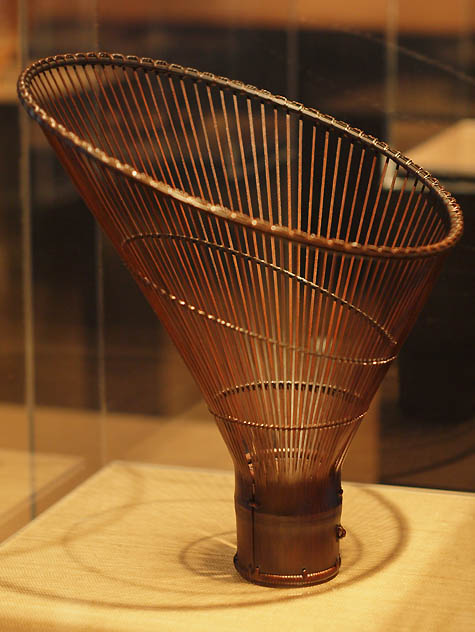 Sound of stars (2011), Chinkuunsai IV 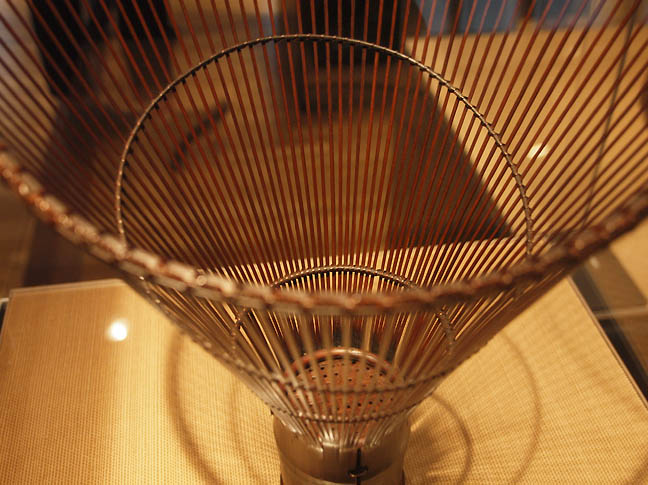 Sound of stars (detail), Chinkuunsai IV This interest in the heavens is echoed in another work by Chinkuusai IV, Sound of stars. Not unlike an artistic bamboo egg wisk or the outlines of a speaker this work evokes the practice of asteroseismology where scientists listen to the ringing vibration of a star to determine its properties, age etc. Here we just have the bell like wonder of such a thing. Who would think that basket weavers were so in touch with scientific exploration? 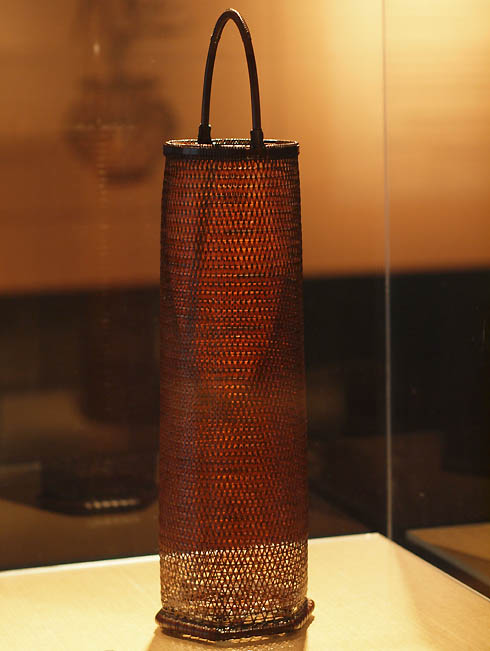 A thousand years, Chinkuunsai II 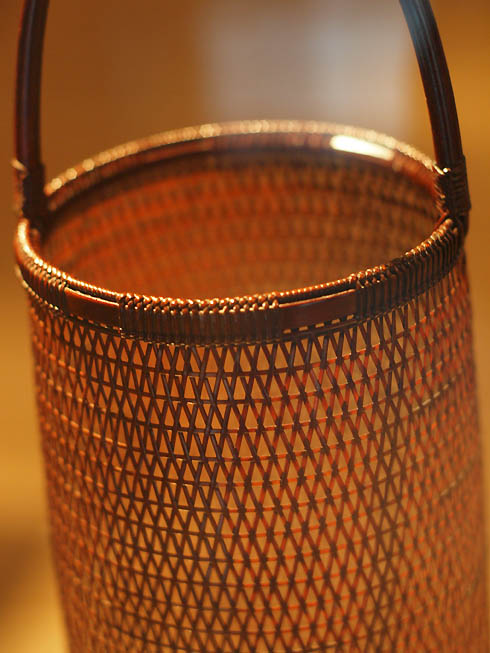 A thousand years (detail), Chinkuunsai II There is so much variety here, some are like towers, others use a gangly bamboo root while some evoke the most elegant lampshade... so elegant in fact that it doesnt require a light bulb, it just exists as a manifold spatial construction as great Western artists like Donald Judd called them. 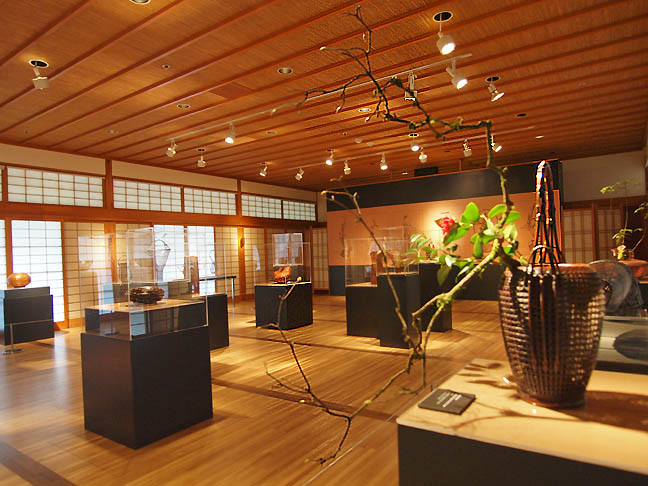
But perhaps the greatest experience here is experiencing the rib cages of dead bamboo playing host to ikebana where the woody limbs and supple greens dance as they deteriorate over a week. Outside, the Spring season is in full eruptive mode but here anything green is still fleeting. It helps us see the vibrancy in the ikebana and that of the world outside the Japanese Garden's gallery. I find myself more aware of each breath as I gaze at the exhibition and the images of it I took. These are nets, fabrics, structures and bones of things. This is one of the strongest exhibitions I have ever seen in Portland and a revelation that it comes from the collection of one of its residents. If it were a touring greatest hits tour of baskets it wouldnt have the personal choice of the collector running through it... he seems to like taller and or less traditional forms with a lyrical bent. Hanakago: The Art of Bamboo and Flowers runs through April 1 Posted by Jeff Jahn on March 24, 2018 at 22:01 | Comments (0) Comments Post a comment Thanks for signing in, . Now you can comment. (sign out)
(If you haven't left a comment here before, you may need to be approved by
the site owner before your comment will appear. Until then, it won't appear
on the entry. Thanks for waiting.)
|
| s p o n s o r s |
 |
 |
 |
 |
 |
 |
 |
 |
 |
 |
 |
 |
 |
 |

|
Site Design: Jennifer Armbrust | • | Site Development: Philippe Blanc & Katherine Bovee | |

